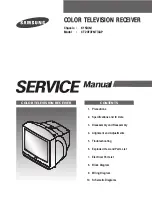
2.3 Contents and Accessories
A. RCA / double SCART adaptor (labelled TRANSMITTER)
B. RCA / SCART adaptor (labelled RECEIVER)
C. Mini DIN / RCA cable (NO S-video)
D. RCA cable
E. Infrared Extender with 3 LEDs
F. PC Audio adaptor
G. Power supply adapters (labelled TRANSMITTER and RECEIVER)
3. Setup of the Transmitter
1. Input of the RCA cable: Insert the DIN end of the RCA cable into the connector of the transmitter. Insert the other
end into the transmitter SCART adaptor, match the colours, or directly into the A/V source. If the source inputs are
coloured differently, connect the yellow plug into the VIDEO, the red plug into the AUDIO RIGHT and the white plug
into the AUDIO LEFT (go further from step 3).
2. Connection to the Audio / Video source you want to transmit pictures: Insert the double SCART adaptor into the
SCART plug of the audio/video device you want to transmit the picture (VCR, SAT decoder, etc.). Using a SCART
cable, connect the other side of the double SCART adaptor to a TV.
3. IR emitter LEDs with self adhesive back surface: In order to control the video sources remotely, connect the small
cable plug into the back of the transmitter. Mount one of the LEDs on the receiving eye, on the front of the VCR, DVD
or SAT receiver. This area looks like a smoked or dark plastic window. To find the right location, you will have to test
that your appliance answers to the original remote control, once you have completely finished the installation of the
video sender and the video receiver. Once satisfied, press the LED firmly on the surface (this will not damage your
equipment).
4. 433 MHz antenna: Lift the antenna up to vertical position
5. Channel selection (on the top of the transmitter)Four channels (A, B, C or D) are available. It allows you to connect
up to 4 independent
systems. Select the same channel on the transmitter as the receiver you wish to link.
6. Transmitting antennaSends the audio / video signal to the receiver. Position the transmitter in a convenient
location and point the transmitter antenna towards the receiver.
7. Power switch: Put the Power Switch on the ON position. In front of the transmitter, there
is a blue LED. It is always on when the transmitter is connected to the power and ready to
transmit.
8. Power supply input: Insert the transmitter power supply cable into this input.
4. Setup of the receiver:
1. Input of the RCA cableInsert one end of the RCA cable into the connectors of the receiver, be sure to match the
colours. Insert the other end into the receiver SCART adaptor, match the colours, or directly into the remote TV. If the
TV inputs are coloured differently, connect the yellow plug into the VIDEO, the red plug into the AUDIO RIGHT and
the white plug into the AUDIO LEFT (go further from step 3).
2. Connection to the SCART input of your TVPlug the SCART adaptor into your TV.
3. Connection to the TVIf your TV does not have any SCART input, connect the antenna input of your TV to this
connector using a coaxial cable and select the channel 36 (PALG) / 48 (PAL I) on your TV.
4. 433 MHz antenna Lift the antenna up to vertical position.
5. IR extenderPoint your original remote control towards the IR window on the front of the receiver, to control the
audio video source.
6. Channel switch: under the receiverFour channels (A, B, C or D) are available. It allows you to connect up to 4
independent systems. Select the same channel on the receiver as the transmitter you wish to link.
7. Receiving antennaReceives the audio / video signal from the transmitter. Position the receiver in a convenient
location and point the receiver antenna towards the transmitter.
8. Power switchSlide the switch on the ON position. In front of the receiver, there is a blue LED. It is always on when
the receiver is connected to the power and ready to receive.
9. Power supply input Insert the receiver power supply cable into this input.





























